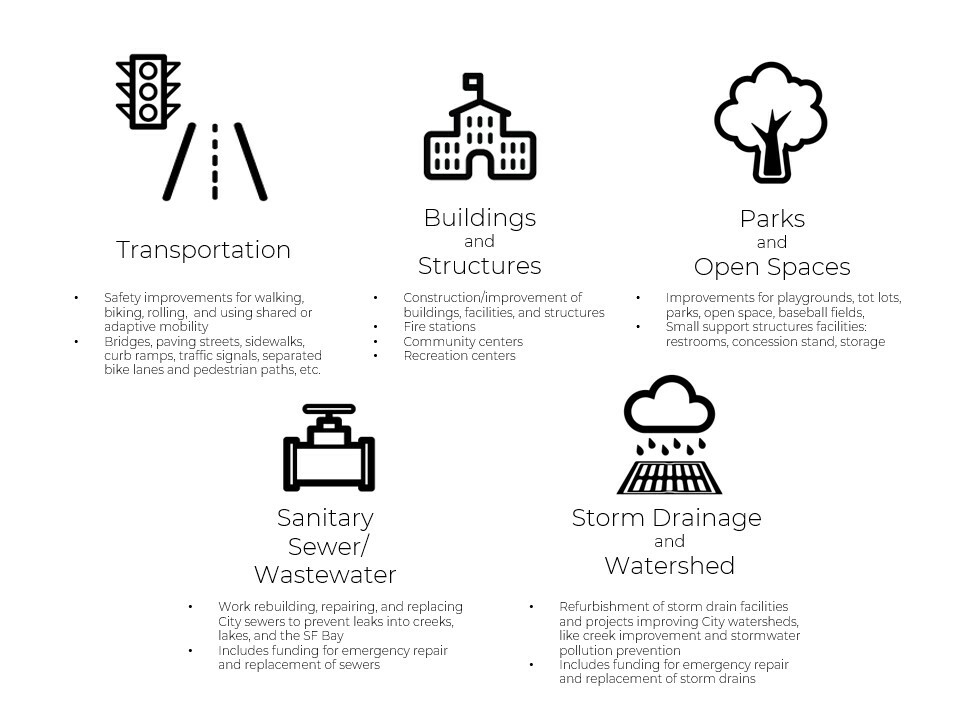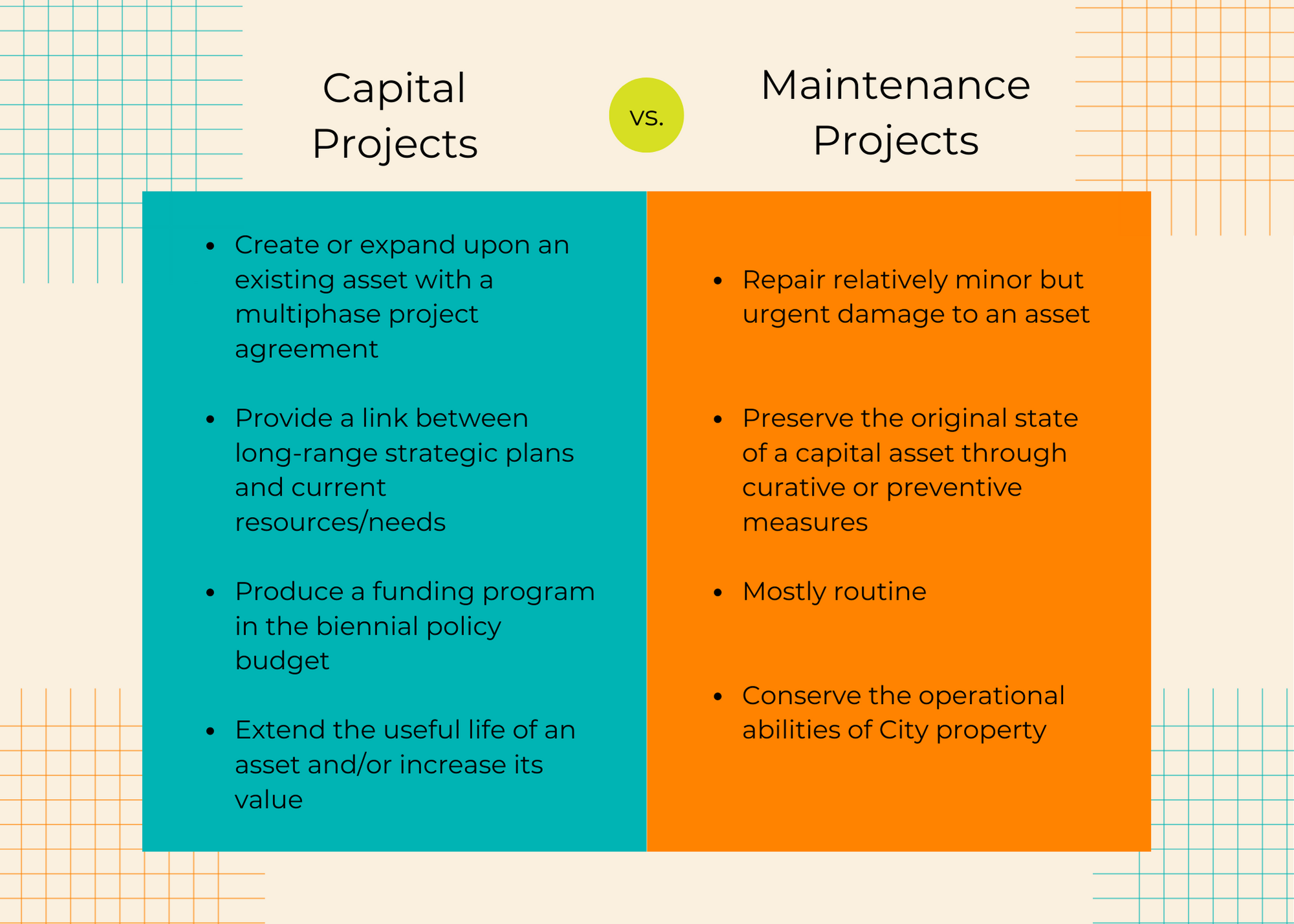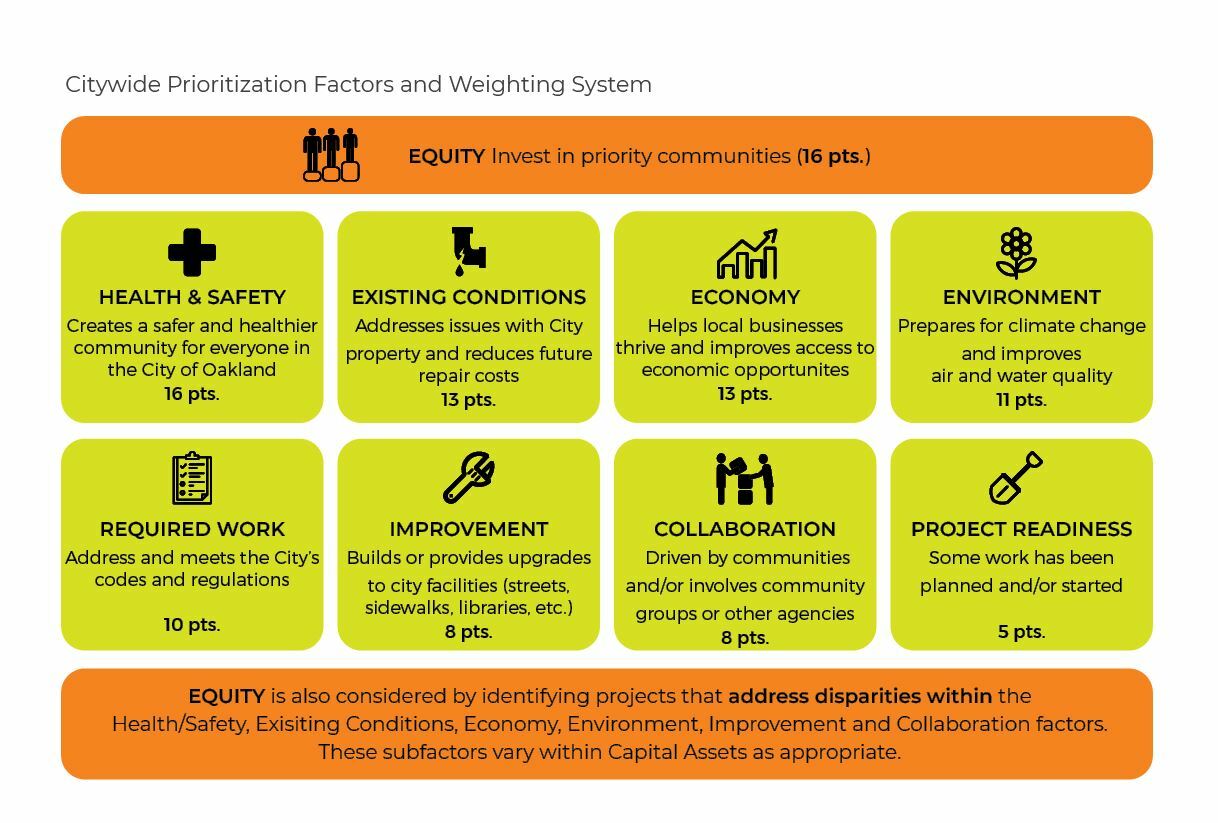Capital Improvement Program

This page provides general information about the City's Capital Improvement Program (CIP).
Explore the Adopted FY 2025-27 CIP
Fiscal Year 25-27 Capital Budget Update
The Fiscal Year 2025-27 Capital Budget was adopted by the Oakland City Council on June 11, 2025. You can explore the adopted budget book by clicking on the yellow button above or following this link. The budget book outlines capital projects funded during the two-year budget cycle beginning July 1, 2025.
Going forward, we will also be aligning the CIP more closely with long term capital planning processes like the City of Oakland General Plan Update to find efficiencies, maximize grant funding opportunities, and deliver projects that help us meet goals identified in multiple planning and public engagement processes. The General Plan Update, in progress now, is the first that will include an Infrastructure and Capital Facilities Element (or topic), which will support and guide capital planning over a twenty-year time horizon. This is a well-timed opportunity for our community to build on participation in past CIP cycles by contributing their voices and needs to this longer-range approach to capital planning. We encourage community members to engage with the General Plan Update process by:
Sign Up for CIP Updates
CIP Projects Interactive Map
About the Capital Improvement Program (CIP)
Capital Project Highlights
The Oakland Department of Transportation (OakDOT) paved 47 miles of Oakland streets and completed nine capital projects in Fiscal Year 2024. For more information about OakDOT capital projects and programs, click on the individual headings and links below. For a map of all transportation projects in Oakland's Capital Improvement Program click here.
Projects Under Construction
Oakland Public Works (OPW) completed 12 capital projects in FY24 including:
- Downtown Oakland Senior Center Improvements
- Holly Mini Park
- Main Library Improvements
There are 19 OPW capital projects currently in construction including:
What is a Capital Project?
The City of Oakland's Capital Improvement Program (CIP) guides the City's long-term, strategic decisions regarding the construction, repair and replacement of the City's assets including libraries, public safety facilities, sewers, recreation centers and parks. Transportation and street improvements are also part of the City's CIP. The City develops a new CIP Budget every two years for inclusion in the overall City Budget, and the assets identified for repair, replacement or purchase in a budget cycle become CIP Projects.
There is also an interactive map of current projects available on this webpage. We will update the map monthly with contact information for each project or program. The map includes filters like project type and council district that community members can use when searching for projects. The "CIP Projects Interactive Map" is linked at the top of this page.

The graphic above describes the five types of capital projects accepted under the Capital Improvement Program.
Capital projects included in the CIP are any large-scale, long-term investment that builds, replaces, or improves an asset (e.g. buildings, roads, parks, sewer, drainage lines, etc.). According to the CIP, capital projects should have a design life of at least ten years and a minimum cost of approximately $100,000.
Before capital projects become official CIP projects, they undergo a prioritization process, where City staff identify assets for repair, replacement, or purchase in the next budget cycle. When the City Council adopts the biennial budget, projects become a part of the two-year CIP. Some of these capital projects are standalone project ideas, while others are part of existing CIP programs that contain specific planning processes.
It's important to highlight that capital projects differ from maintenance projects, which are not within the CIP. Maintenance projects are typically smaller in scale/cost and refer to more urgent short-term repairs to ensure vital city assets remain operational. For urgent maintenance requests (e.g., potholes, graffiti removal, etc.), you can navigate to the City's Oak 311 service, which handles these more routine fixes. Please be advised that Oak 311 receives hundreds of requests and may not be able to respond to your concern immediately.

This table differentiates between capital projects and maintenance, providing more detail on what to consider before submitting a project to the CIP. Use the City's Oak 311 service when submitting any maintenance issues.
Oak 311 Maintenance Service
How a Capital Project is Formed

See this summary for the nine criteria the City of Oakland considers when prioritizing projects for funding. The chart shows definitions for each prioritization factor and the number of points each receives according to the CIP process approved by the City Council.
In 2018, the Oakland City Council adopted a new, inclusive forum for Oakland community members to incorporate their feedback and introduce new project ideas to be considered for the CIP selection process.
Along with it came a new CIP Prioritization Model that would weigh the urgency and projected impact of applicant projects to ensure effective allocation of City dollars. The CIP prioritization process approved by the Oakland City Council scores projects on the factors listed above in the figure.
City staff use the CIP prioritization process to score projects and determine their feasibility given the City's financial and operational constraints within the upcoming two-year budget. Staff present CIP recommendations to the City Council for approval each biennial budget cycle.
It is important to note that not all projects included in the CIP will receive funding in the two year funding cycle. Being included in the CIP is a necessary first step that allows City staff to seek funding for a capital project. Some or all of the funding required to complete a capital project may be included in the two year budget—but more often than not, the City will have to seek additional funding from sources like State grants or public bonds. In either case, these funds are often dedicated to a specific purpose (for example paving roads) and the City may not have the ability to use them for a different purpose (for example renovating a recreation center). However, even when there is not an identified funding source for your capital project, there is still value in submitting your request, because it ensures your project will be in line to be considered for funding when it does become available.
The CIP Process in Motion
The City of Oakland has more demand for capital projects than it has funds to pay for them, which is why the CIP must be intentional about how to score and prioritize potential project ideas generated internally and from public submissions. Community engagement continues to be critical for uplifting the community's real needs—as articulated by community members themselves—to determine priority capital investments. Using the City's prioritization factors (pictured above), the City assigns each project an overall score based on the criteria listed.
City staff present their recommendations to the City Council as part of the budget development process. Once the recommendations are provided to Council, Council holds public meetings to deliberate and adopt a final budget. This is another opportunity for community members to be involved in the process. The dates and times for those meetings are variable each cycle; however, the City Council must adopt its Budget and CIP by June 30 before the beginning of the fiscal year.

Since 2015 the CIP budget has grown significantly, giving it an important role in building new city infrastructure.
The CIP Budget represents a significant investment in our community. It reflects the overall priorities of the City and has an enormous impact on its health and vibrancy. CIP dollars can bring about entirely new community-envisioned changes and speed up the completion of existing projects that may face challenges because of funding shortages.
Links / Additional CIP Info
Find links to additional CIP-related information below.